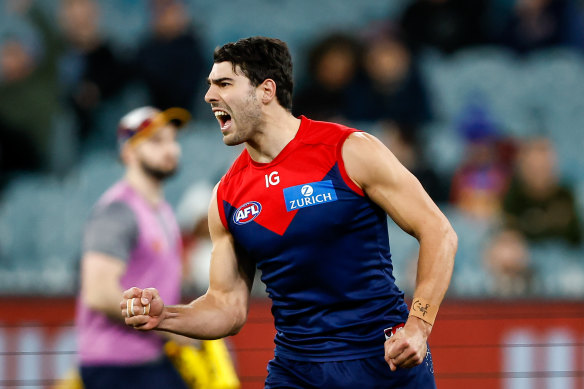Running so hard and fast that you fall off a treadmill might not sound like the ideal way for someone to spend their holidays. But that’s the lot of Melbourne star Christian Petracca, who is one of a number of players taking special steps to try to get an edge over their opponents for the 2024 season.
Petracca – who is increasingly becoming known online for his cooking videos, including a hit “Lasagna soup” how-to with 3.3 million views and rocky road tutorial with 2.5 million views – headed to the Red Bull training camp in Austria, where he took fans through “day in the life” videos.
“Today’s all about checking my health and identifying any niggles from the season. The doctor ran a bunch of tests, including one which measures my lung function and how forcibly I can empty air from my lungs,” he said over footage of what he was describing.
“The most challenging session of the day is the VO2 Max test, where they increase the speed until you literally fall off the treadmill – as you can see here. This measured my threshold performance and aerobic capacity”.
Petracca’s videos go on to document his gym workouts, plyometrics exercises, weights program, mobility circuits, running sessions and cognitive training to help improve his reaction time and hand-eye coordination. Plus a bit of creamy pesto pasta and a recovery session in the cryo chamber.
Indicative of the popularity of this footage, reaching far outside the AFL bubble, one of the top comments reads “What sport does he do?”

Christian Petracca will again be a key for the Demons.Credit: AFL Photos
Petracca isn’t the only player to head overseas in a bid to improve this off-season.
A crop of 15 Essendon players, including Kyle Langford, Andrew McGrath and Jordan Ridley, flew to the USA and took it upon themselves to fund a two-week, high-altitude training camp in Phoenix, Arizona. At Exos Pro Sports Training Centre, they aimed to better themselves for the 2024 season with scientific methods of recovering, rebuilding and developing techniques.
It’s a move reminiscent of pre-season programs from more than a decade ago, when expensive altitude training camps were all the rage for AFL clubs, pioneered in part by former premiership coach Mick Malthouse.
Ahead of the 2006 season, the Magpies spent about $180,000 on a two-week, high-altitude training camp in Flagstaff, Arizona, which helped them climb the ladder.
Subsequently, other clubs followed suit and by 2013 it had almost become the norm with the Brisbane Lions, Carlton, Essendon, Gold Coast, North Melbourne, St Kilda and the Western Bulldogs all having sent their playing groups to the United States, while Hawthorn went to a high-altitude facility in South Africa.
However, critics came for the effectiveness of these camps, including physiologists, who argued results were often short-lived.
Dr Ian Gillam from Exercise and Sports Science Australia said there was no scientific evidence to support the belief that altitude training enabled players to train harder on return.
“I’ve looked at a number of bits of evidence on that and I can’t find anything that’s actually documented about [players being able to train harder],” Gillam told AFL.com.au.
“It might be anecdotal but there’s certainly no scientific evidence to actually say that’s real.”
But high altitude wasn’t the only element of the Bombers’ camp and McGrath was certain there would be benefits for the players who took part.
“We know that every other club wants the same thing, so we have to push in a slightly different direction, or find little gains here and there that every club is searching for,” Andrew McGrath told News Corp earlier this month.
“If that makes one per cent difference to our season next year, it will be 100 per cent worth it.”
Players don’t have to be abroad to find new ways to improve. Collingwood’s Tom Mitchell, who recently added a premiership medal to his accolades including a Brownlow and two All-Australian blazers, used social media to share his pursuits, saying the off-season was “the perfect time to try some different techniques to try and get better”.
He took fans through a group session with the likes of Nick Daicos, Bobby Hill and Jordan De Goey, which included gymnastics, cross-training, Jiu Jitsu, gym and skills training and running.
In another, he explained some of his DNS training (dynamic neuromuscular stabilisation), which works on locomotion and movement patterns, footwork and being effective at ground level.
“Clearly, my whole footy game is based on being good at ground level, so [I have] been working with my movement coach on a number of different patterns to be efficient, to get out of trouble,” he said over footage of him moving with the ball low to the ground.
“Obviously, we know you can burst through tackles but having manoeuvres, such as pivoting, reverse pivoting, can be very effective when training ground balls.”
Despite the AFLW season only finishing earlier this month, many players are still hitting the track.
“Chucked some Nicki Minaj on the telly and then we were straight into a bit of a home workout,” Adelaide fan-favourite Jess Waterhouse said in one of their “day in the life” videos on TikTok while away on holidays.
“’Cause we don’t have much access to too much equipment we’re just trying some new movements and then also with a higher rep range as well… Then I grabbed Delilah [their dog], and we headed down to the local footy oval to get a few laps in.”
Keep up to date with the best AFL coverage in the country. Sign up for the Real Footy newsletter.